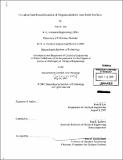Covalent end-immobilization of oligonucleotides onto solid surfaces
Author(s)
Lee, Ivan H. (Ivan Hao), 1967-
DownloadFull printable version (24.48Mb)
Other Contributors
Massachusetts Institute of Technology. Dept. of Chemical Engineering.
Advisor
Paul E. Laibinis.
Terms of use
Metadata
Show full item recordAbstract
With the completion of the Human Genome Project, the focus of genetics research has shifted towards functional genomics, with emphasis on gene expression and polymorphism studies. To this end, there is rapidly increasing interest in solid-phase, high-throughput, combinatorial microarrays for DNA assays. For this purpose I synthesized oligonucleotides (oligos) stepwise onto derivatized SiO2 surfaces. Then double-stranded (ds)DNA molecules with "dangling end" oligo overhangs were immobilized onto the oligo surface by hybridization. Photolysis of psoralen crosslinkers covalently immobilized the dsDNA molecules to the oligo surface. The covalently end-attached dsDNA formed brush-like structures where the dsDNA strand could react under conditions resembling the natural solution-state found in vivo. This method minimized the possibility of nonspecific surface interactions, and could be developed for site-specific segregation of mixed dsDNA sequences from solution onto surface microarrays. Oligo surfaces with different densities were synthesized to determine the conditions that optimize dsDNA hybridization. The oligo surface density was controlled by derivatizing the Si02 surface with mixed compositions of alkylsilane molecules (X-(CH2)11-SiCl3, X= OH or CH3). X-ray photoelectron spectroscopy was used in conjunction with commercially available iodine-labeled nucleotides for quantifying oligo surface densities and stepwise reaction (coupling) efficiencies. (cont.) 32P-radiolabeled complementary oligos and dangling-end dsDNA sequences also were used to determine hybridization yields and efficiencies. The experimental results clearly indicated that oligo coupling efficiency increased with decreasing oligo surface density, and also with increased coupling time. Consequently, I maximized the yield of full-length surface oligos by manipulating these reaction conditions. In addition, hybridization efficiency was inversely related to oligo surface density, and total hybridization yield was achieved at an oligo surface density of between 2 and 4 x 10-13 moles/cm2. The oligo surfaces were found to be thermally stable and reusable for performing multiple hybridization experiments on glass slides. dsDNA with 5' oligo overhangs were generated by PCR with a customized oligo primer. The dsDNA molecules were successfully immobilized onto oligo surfaces, at surface densities of approximately 2 x 10-13 moles/cm2. The spatial addressability of patterned oligo surfaces was demonstrated. Psoralen crosslinking was observed to proceed at 30-80% efficiency, compared to optimal 50% efficiency in solution phase. Upon heating the end-immobilized dsDNA unraveled to form covalently end-immobilized ssDNA probes with sequence lengths up to 390 bp that were employed in hybridization studies.
Description
Thesis (Ph. D.)--Massachusetts Institute of Technology, Dept. of Chemical Engineering, 2001. Includes bibliographical references.
Date issued
2001Department
Massachusetts Institute of Technology. Department of Chemical EngineeringPublisher
Massachusetts Institute of Technology
Keywords
Chemical Engineering.